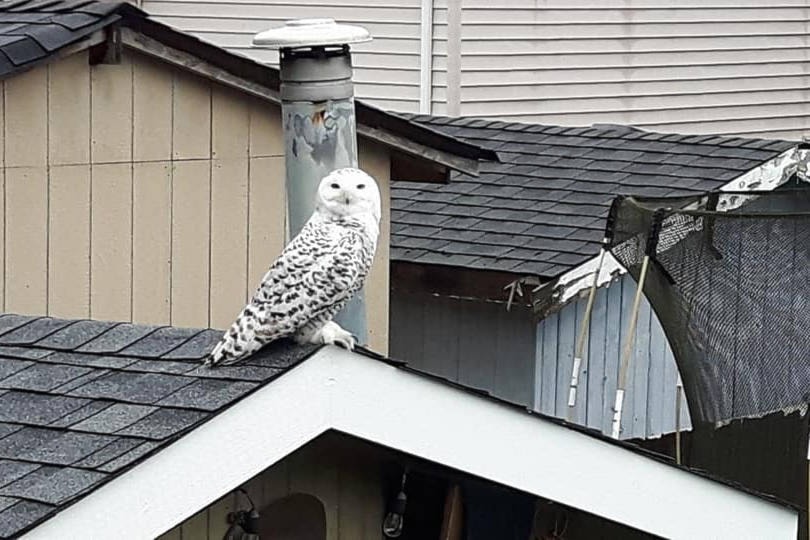Perched on a rooftop, just visible from Jennifer Heroux-Flathen’s suburban backyard, a snowy owl sat quietly.
Heroux-Flathen’s school-age daughter was home sick with the flu on Tuesday, Feb. 6. She was the one who saw the owl, enjoying a rest during the overcast mid-morning.
“She came and got me, ‘Mommy, mommy there’s an owl in the back yard,’” Heroux-Flathen said laughing.
“I thought she was joking.”
They sat watching the owl for around an hour, and although the neighbourhood family of crows wasn’t very happy, Heroux-Flathen certainly was.
“It’s a stunning thing to see,” she said.
“It’s so rare. I’ve never seen that before.”
Heroux-Flathen’s new neighbour was one of Delta’s visiting snowy owls, a northern species known best for its quiet hunting over snowy ground and its role as Hedwig Harry Potter’s pet, and it wasn’t the first spotted in North Delta over the past few months.
One, possibly a male judging from the light brown flecks on its wings, was seen relaxing in a tree by the North Delta post office in late January.
And there were two sightings of what may have been the same female only four days apart in early February in the area of 116th Street and 90th Avenue.
According to Orphaned Wildlife Rehabilitation Society (OWL) raptor manager Rob Hope, it’s not as rare as people might think to see these northern hunters so far south.
Every four or five years, young owls migrate south to feed, sometimes travelling as far as Oregon or California. Hope said it has been six years since significant numbers of owls were seen in Delta.
“Normally they’re found on the foreshore of Delta,” around Boundary Bay and Brunswick Point, he said. “But this year there’s only been a few there spotted.”
That means those owls have been striking out and venturing into more urban areas like Burnaby, Surrey and, of course, North Delta.
And the only reason they would be in those areas, Hope said, is for food.
Heroux-Flathen’s snowy owl was likely hunting when she spotted it on the neighbouring rooftop.
Snowy owls hunt during the day, unlike other owls which wait for the cover of night.
During their southern stays they feed primarily on small mammals (ranging in size from mice to jackrabbits) and other birds (including everything from sparrows to ducks to pheasants).
Their native tundra habit has few trees, making them more likely to sit on a rooftop or fence and search for prey, Hope said. When they see a target, they swoop down from their perch and swallow the meal whole.
Snowy owls migrate because the warmer climates makes it easier to find food — especially when it can be hidden under several feet of snow. But that doesn’t make these migrations a tropical holiday.
Often, birds will arrive in Delta starving and weary after their long travels.
The change in climate from a cold, dry area to a warm, moist one can also spur fungal infections that attack their organs.
To keep the birds healthy, Hope recommends viewers keep the birds’ stress to a minimum.
“If somebody’s got it in their backyard, take pictures, but you don’t want 50 people showing up, harassing the bird to try and get a picture,” he said. “That’s more stress they don’t need.
“And if they just let them do their natural thing, they will be fine. They’ll find enough food and probably in another month or so they’ll start to head back north.”
grace.kennedy@northdeltareporter.com
Like us on Facebook and follow us on Twitter
